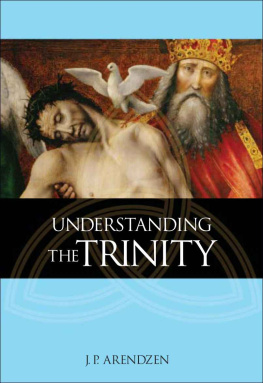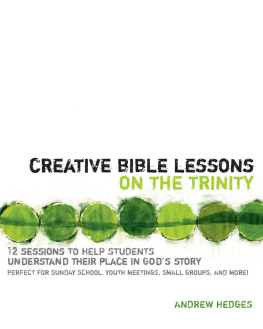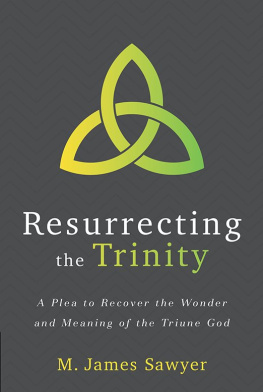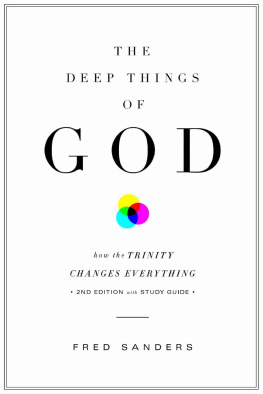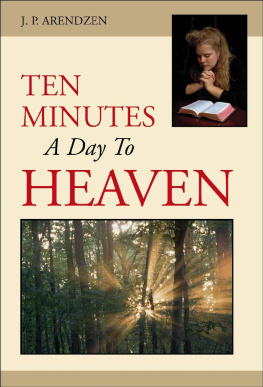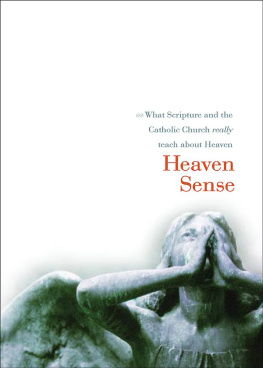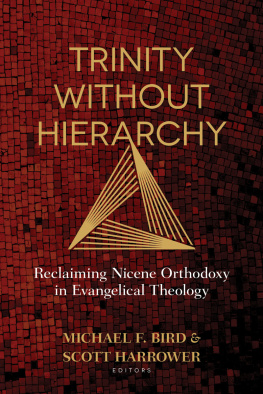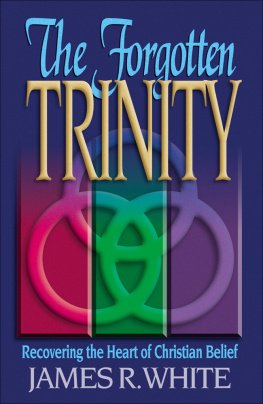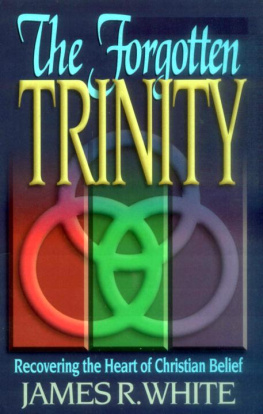J. P. Arendzen - Understanding The Trinity
Here you can read online J. P. Arendzen - Understanding The Trinity full text of the book (entire story) in english for free. Download pdf and epub, get meaning, cover and reviews about this ebook. year: 2011, publisher: Sophia Institute Press, genre: Religion. Description of the work, (preface) as well as reviews are available. Best literature library LitArk.com created for fans of good reading and offers a wide selection of genres:
Romance novel
Science fiction
Adventure
Detective
Science
History
Home and family
Prose
Art
Politics
Computer
Non-fiction
Religion
Business
Children
Humor
Choose a favorite category and find really read worthwhile books. Enjoy immersion in the world of imagination, feel the emotions of the characters or learn something new for yourself, make an fascinating discovery.
- Book:Understanding The Trinity
- Author:
- Publisher:Sophia Institute Press
- Genre:
- Year:2011
- Rating:3 / 5
- Favourites:Add to favourites
- Your mark:
- 60
- 1
- 2
- 3
- 4
- 5
Understanding The Trinity: summary, description and annotation
We offer to read an annotation, description, summary or preface (depends on what the author of the book "Understanding The Trinity" wrote himself). If you haven't found the necessary information about the book — write in the comments, we will try to find it.
Understanding The Trinity — read online for free the complete book (whole text) full work
Below is the text of the book, divided by pages. System saving the place of the last page read, allows you to conveniently read the book "Understanding The Trinity" online for free, without having to search again every time where you left off. Put a bookmark, and you can go to the page where you finished reading at any time.
Font size:
Interval:
Bookmark:


Understanding the Trinity
Also by J. P. Arendzen
from Sophia Institute Press:
Ten Minutes a Day to Heaven
J. P. Arendzen
SOPHIA INSTITUTE PRESS
Manchester, New Hampshire
Understanding the Trinity was originally published in 1937 by Sheed and Ward, London, under the title The Holy Trinity. This 2004 edition by Sophia Institute Press contains minor editorial revisions to the original text.
Copyright 2004 Sophia Institute Press
All rights reserved
Cover design by Theodore Schluenderfritz
No part of this book may be reproduced, stored in a retrieval system, or transmitted in any
in any form, or by any means, electronic, mechanical, photocopying, or otherwise,
without the prior written permission of the publisher, except by a reviewer,
who may quote brief passages in a review.
Sophia Institute Press
Box 5284, Manchester, NH 03108
1-800-888-9344
www.sophiainstitute.com
Nihil obstat: H. E. Calnan, Censor Deputatus
Imprimatur: Can. S. Banfi, Vicar Generalis
Southwarci, January 19, 1937
Library of Congress Cataloging-in-Publication Data
Webb, Bruno.
Why does God permit evil? / Bruno Webb.
p. cm.
Originally published: London : Burns, Oates
Washbourne, 1941.
ISBN : 1-928832-15-6
1. Good and evil. 2. Suffering. I. Title.
BJ1408.W4
2004 231.8 dc22 2004006477
04 05 06 07 08 09 10 9 8 7 6 5 4 3 2 1






In this treatise an attempt has been made to write about the mystery of the Blessed Trinity in a nontechnical way. It is obviously impossible to make such a treatise popular in the usual sense of the word, but the treatment might be made less forbidding to the laity than it often is. It seemed worth trying even to make it devotional in the sense of bringing out its beauty and attractiveness, the marvel and the grandeur of its truth. The author is keenly conscious of the imperfections of his own treatment, and yet hopes that with all its shortcomings, it might be a help to some to give more glory to the Father, to the Son, and to the Holy Spirit.
J. P. Arendzen
January 1, 1937
Editors note: The biblical quotations in the following pages are taken from the Douay-Rheims edition of the Old and New Testaments. Where applicable, quotations have been cross-referenced with the differing names and enumeration in the Revised Standard Version, using the following symbol: (RSV =).

Understanding the Trinity

divine intimacy with Him
From the earliest ages, wise men have puzzled over the problem of the One and the Many.
This world displays a wonderful variety and multiplicity of things to the wistful eye of man. Myriad objects affect his senses; countless substances and beings surround him. Although at first overwhelmed by their seemingly endless number, man never despaired somehow to reduce this manifoldness to some kind of coherence. And coherence means unity, some principle and power essentially one and undivided, from which all plurality descends.
A small section of mankind has completely lost its way in the search for the final unity underlying bewildering diversity. They went astray into the dreamland of pantheism. They sought the center of this far-flung univers within this universe itself. The many were not really many; they were the One. The manifold world, perceptible to the senses, was only a phantom, they said, an illusion; the ultimate Reality was one Being which manifested or unfolded Himself in these endless phenomena, this shoreless sea ever-moving. Phenomena is but the Greek for things that seem, things that appear, but the Thing underneath, was the one and only Thing that really existed; all things else were but a passing show. They were but the flickering, dancing lights on the bosom of the ocean. They were but the sheen of the billows, and the billows were the ocean itself and had no existence apart from its fathomless waters. Even men themselves, they maintained, were deceived in their individuality, their contrast between I and Thou, for in the very depth of reality, I and Thou were the same, and self-hood was the deceitful glow and phosphorescence of an ignis fatuus. The supreme wisdom of man consisted in realizing that All was One and One was All and to recognize in his ego the Infinite One, the Absolute, and say, I am All, and All is I.
Thus, in his feverish search for the One in the Many, mans brain became palsied, and denying the stark reality of the distinctness of things in him and around him, he stared as with the glassy eyes of the sick on the imagined spot of light, which to him became the whole of all that is, and he fancied he saw the totality of the universe in a mathematical point.
This mental disease has afflicted and still afflicts many, and great numbers are under the influence of soporific pantheism, but happily man in the mass is too sound and sane to forget the difference between himself and his neighbor or to imagine himself one with the rock or with the lichen upon it, or to think that he is his dog and his dog is he.
Common sense acknowledged the multifarious abundance of distinct objects in this varied world, but found the unity in the cause that produced them. Men found a transcendental unity above and beyond the visible world in the one Being which, with creative power, called this universe into being, as a multiple reflection of His own undivided, infinite glory. As a cunning workman or an inventive artist might produce a profusion of widely varying objects and yet not lose his own individuality, the indivisible unity of his own personality, so God, utterly one in Himself, could produce this myriad-fold world without losing the unity of His nature. Only in this sense are all things one that they are made by One; and being made by One, they all show forth the mind of the One, however varied among themselves they may be.
Nor, having created them, does that One leave them, but maintains them in being and thus continually impresses the unity of His mind upon them. All human science is but an endeavor to think once more the Thought that once made the world and now holds it in being. True science does not foolishly deny the multitude of distinct creatures, but reduces to ever higher unity the powers and laws that keep it and rule it.
God, who is the One, infinite in power and wisdom, conceived, planned, designed, and executed this intricate scheme of the great created All that we men style the universe in its vastness and multiplicity. But the finite, however large, does not exhaust the Infinite. The Infinite can dwell in the finite, but cannot be contained by it. The Infinite can hold the finite, but cannot be held by it. It can possess and pervade it, but not be possessed by it. God remains the infinitely Transcendent, although He is present within all that He has made. So far, then, human reason can pursue the trace of the Eternal and demonstrate that beyond, and yet within, the many there lies the One, who is cause of the many and who, in creating the many, yet never lost divine unity, existing without parts or divisions in the oneness of divine nature.
Font size:
Interval:
Bookmark:
Similar books «Understanding The Trinity»
Look at similar books to Understanding The Trinity. We have selected literature similar in name and meaning in the hope of providing readers with more options to find new, interesting, not yet read works.
Discussion, reviews of the book Understanding The Trinity and just readers' own opinions. Leave your comments, write what you think about the work, its meaning or the main characters. Specify what exactly you liked and what you didn't like, and why you think so.

